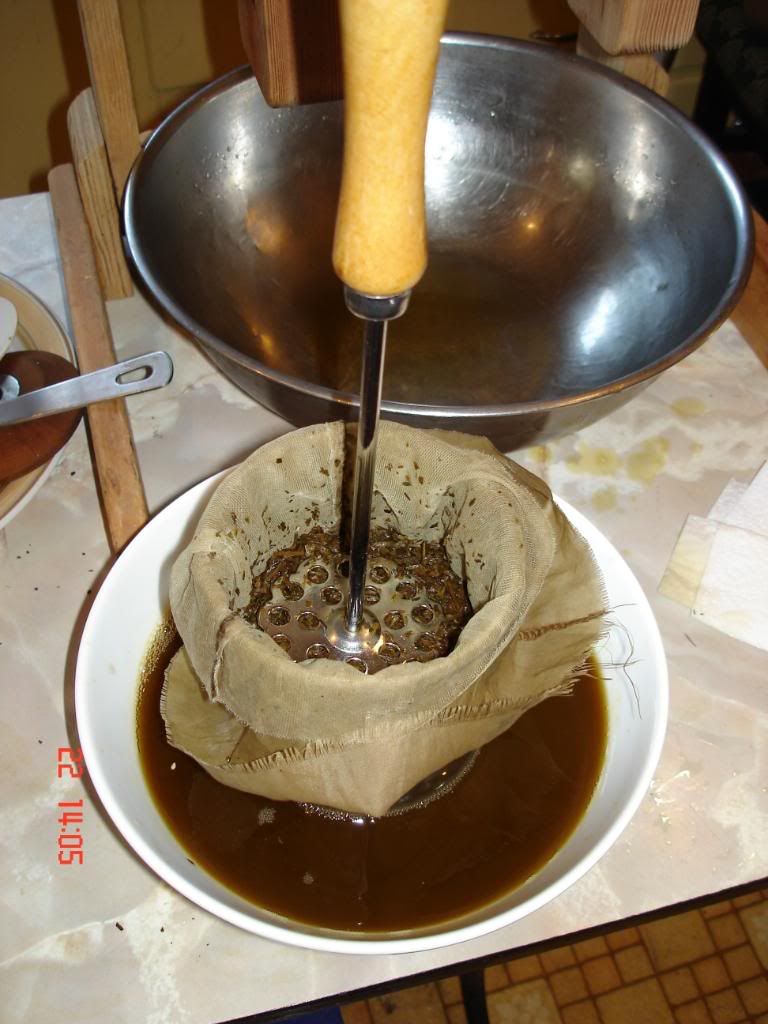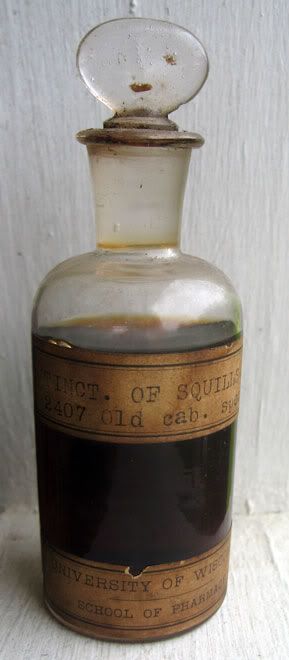
After posting so much I never know if I am repeating a similar post or not.
For those that dont know how to make a Tincture I will explain.
Making an Herb or Wild Plant Tinture.
You can make tinctures from fresh and dried roots as well as from fresh flowers and leaves.Tinctures Act Fast
Tinctures are alcohol-based plant medicines. Alcohol extracts and concentrates many properties from plants, including their poisons. Alcohol does not extract significant amounts of nutrients, so tinctures are used when we want to stimulate, sedate, or make use of a poison. (Remember that nourishing herbs are best used in water bases such as infusions and vinegars.)
The concentrated nature of tinctures allows them to act quickly.A little goes a long way.

Making Dried Root Tinctures
I strongly prefer to make tinctures from fresh plants. But many people have a hard time getting fresh plants. Most books therefore ignore fresh plant tinctures and focus on making tinctures only from dried plants. The only dried plant parts I use to make tinctures are roots and seeds. All other plant parts I use fresh when making a tincture. And I actually prefer to use fresh roots too.
To make a tincture from dried roots:
Buy an ounce of dried Echinacea augustifolia or Panax ginseng root or better yet...Grow your own.
Put the whole ounce in a pint jar.
The dried root should fill the jar about a third full. If not, use a smaller jar.
Fill the jar to the top with the alcohol. Cap tightly and label.
Almost any alcohol can be used to make a tincture. My preference is 100 proof vodka. A lower proof, such as 80 proof, does not work nearly as well. Higher proofs, such as 198 proof or Everclear, can damage the liver and kidneys, so I don't use them to make medicine.
The tincture is ready in six weeks, but gets stronger the longer it sits. I like to wait about six months before using my ginseng tincture and a year before using my echinacea tincture.

Making Fresh Root Tinctures
Roots generally hold their properties even when dried. But two of my favorite root tinctures must be made from fresh roots are the dried ones have lost much of their effect.
Making a tincture with a fresh root is similar to making one with a dried root.
With great respect for the plant, dig up its root.
Gently rinse mud away.
Chop root into small pieces and fill a jar to the top with the chopped root.
Fill jar to the top with alcohol. Cap tightly. Label.
Fresh root tinctures are ready to use in six weeks.
Making Fresh Leaf and Flower Tinctures
I use only fresh flowers and leaves in my tinctures. These delicate plant part lose aroma and medicinal qualities when dried.
Tinctures can be made from dried herbs, but I find them inferior in in both effect (how well they work) and energetics (how many fairies are in it), not to mention taste (how many volatile substances remain) and somatics (how something makes you "feel").

Plant Poisons
You remember that there are four types of poisons in plants: alkaloids, glycosides, essential oils, and resins. The first three are fairly easy to move from plants to a tincture.
Resins, because they "fear" water (hydrophobic) are difficult to tincture. When I want to tincture a resin I do use high proof alcohol. Some examples would be: pine resin tincture, balsam bud tincture, calendula flower tincture.

Taking Tinctures
I see many people put herbal tinctures under their tongues. I prefer to protect my oral tissues from the harsh, possibly cancer-causing, effects of the alcohol.
I dilute my tinctures in a little water or juice or even herbal infusion and drink them.
YARROW

Using Your Tinctures
Here are a few of the ways I use the tinctures in my herbal medicine chest. For more information on using these tincture, see my books and my website.
Acid indigestion: 5-10 drops of Dandelion root or Wormwood tincture every ten minutes until relieved. I use a dose of Dandelion before meals to prevent heartburn.
Bacterial Infections (including boils, carbuncles, insect bites, snake bite, spider bite, staph): 30-50 drops Echinacea or Yarrow tincture up to 5 times daily. For severe infections, add one drop of Poke tincture to each dose.
Colds: to prevent them I use Yarrow tincture 5-10 drops daily; to treat them, I rely on Yarrow, but in larger quantity, say a dropperful every 3-4 hours at the worst of the cold and tapering off.
Cramps during menstruation: 10 drops Motherwort every 20 minutes or as needed. Used also as a tonic, 10 drops daily, for the week before.
Cramps in muscle: 25 drops St Joan's every 25-30 minutes for as long as needed.
Cramps in gut: 5-10 drops Wormwood, once.
Diarrhea: 3 drops Wormwood hourly for up to four hours.
Energy lack: 10 drops of Dandelion or Ginseng tincture in the morning.
Fever: 1 drop Echinacea for every 2 pounds of body weight; taken every two hours to begin, decreasing as symptoms remiss. Or a dropperful of Yarrow tincture every four hours.
Headache: 25 drops St Joan's plus 3-5 drops Skullcap every 10-15 minutes for up to two hours. 5 drops of Skullcap may prevent some headaches.
High blood pressure: 25 drops of Motherwort or Ginseng tincture 2-4 times a day.
Hot Flashes: 20-30 drops Motherwort as flash begins and/or 10-20 drops once or twice daily.
Insect: prevent bites from black flies, mosquitoes, and ticks with a spray of Yarrow tincture; treat bites you do get with Yarrow tincture to prevent infection.
Nervousness, hysteria, hyper behavior: 15 drops Motherwort every 15-20 minutes.
Premenstrual distress: 10 drops Motherwort twice a day for 7-10 days preceding menstruation or 10 drops daily all month.
Sore throat: Gargle with Yarrow tincture.
Swollen glands: 1 drop Poke root tincture each 12 hours for 2-5 days.
Viral infections (including colds and the flu): 25 drops of St. Joan's wort tincture every two hours. Add one drop of poke root tincture 2-4 times a day for severe cases.
Wounds: I wash with Yarrow tincture, then wet the dressing with Yarrow tincture, too.
wow thanks... I was just digging into exploring more on this topic. I have learned a few different ways but am eager to experiment myself... Thank you for the guidance. Much love.
ReplyDeleteThank you Lauren.
ReplyDeleteThanks for sharing the thoughts about the Tincture Packaging and also CBD boxes. Keep sharing and also thanks for sharing
ReplyDeleteYour thoughts about the Tincture Packaging is meaningful and very helpful to others. Thanks for sharing and also keep sharing up in future such a informative articles.
ReplyDeleteI really appreciate your thoughts and idea about the Tincture Packaging. Thanks for sharing.
ReplyDeleteCBD Boxes give a stunning looks to your cbd products and increase your sales.
ReplyDeletePowerhouse is a novel concept of a superstore featuring the latest in Electrical and Electronic Products, High-Quality Lights, and World-Class Building Materials
ReplyDeletehttps://powerhouse.com.pk/